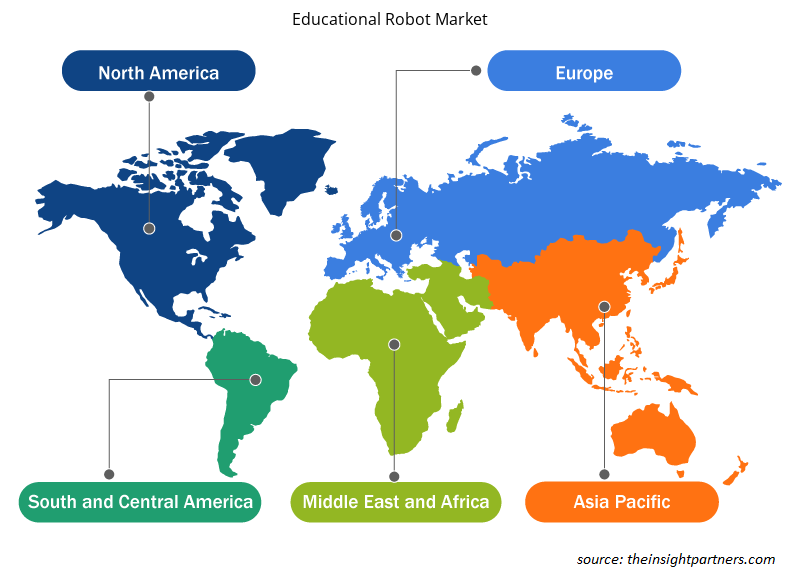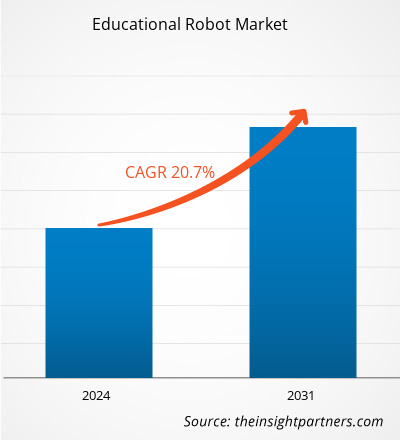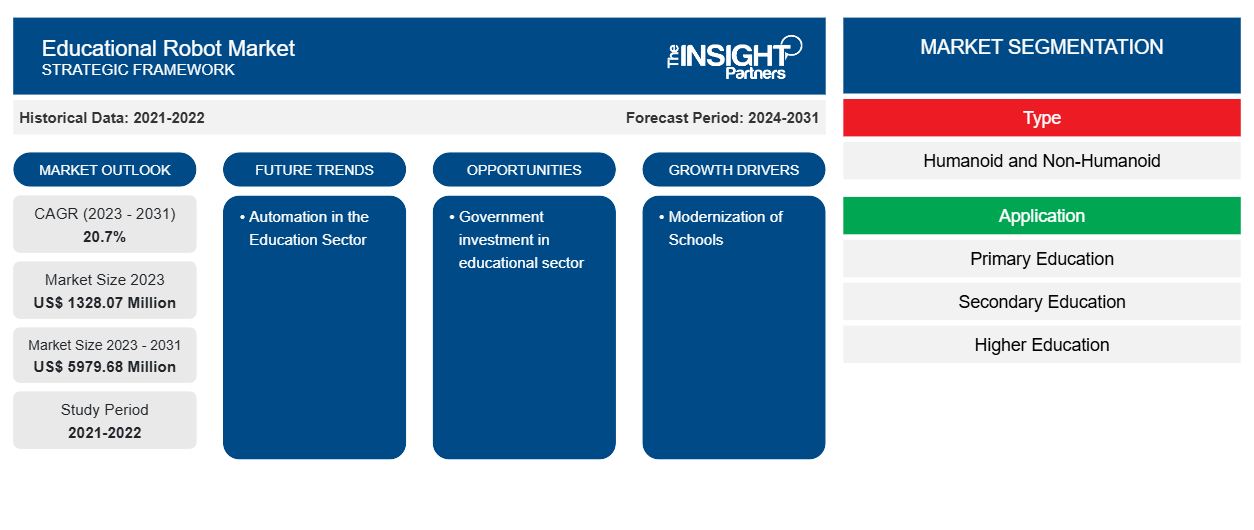Der Markt für Bildungsroboter soll von 1.328,07 Millionen US-Dollar im Jahr 2023 auf 5.979,68 Millionen US-Dollar im Jahr 2031 anwachsen. Der Markt soll zwischen 2023 und 2031 eine durchschnittliche jährliche Wachstumsrate (CAGR) von 20,7 % verzeichnen. Die staatlichen Investitionen in Robotik und Automatisierung im Bildungssektor dürften weiterhin wichtige Trends auf dem Markt bleiben.
Marktanalyse für Lernroboter
Der zunehmende Fokus auf die Förderung von Wissenschaft, Technologie, Ingenieurwesen und Mathematik (STEM) treibt das Marktwachstum voran. Die Investitionen der Regierungsbehörden in das Bildungssystem fördern das Marktwachstum zusätzlich. Schulen und Hochschulen berücksichtigen verschiedene Aspekte der Robotik, was das Marktwachstum vorantreibt.
Marktübersicht für Lernroboter
Lernroboter sind programmierbare Roboter, die es Schülern aller Altersstufen ermöglichen, ihr Wissen über Robotik und Programmierung zu vertiefen. Darüber hinaus helfen sie ihnen beim Erlernen anderer kognitiver Fähigkeiten. Sie bieten Schülern alles, was sie zum Bauen und Programmieren eines Roboters benötigen, der eine Vielzahl von Aufgaben ausführen kann.
Passen Sie diesen Bericht Ihren Anforderungen an
Sie erhalten kostenlose Anpassungen an jedem Bericht, einschließlich Teilen dieses Berichts oder einer Analyse auf Länderebene, eines Excel-Datenpakets sowie tolle Angebote und Rabatte für Start-ups und Universitäten.
-
Holen Sie sich die wichtigsten Markttrends aus diesem Bericht.Dieses KOSTENLOSE Beispiel umfasst eine Datenanalyse von Markttrends bis hin zu Schätzungen und Prognosen.
Treiber und Chancen auf dem Markt für Lernroboter
Modernisierung von Schulen
Die Regierung investiert massiv in den Bildungssektor, um die Schulen und Hochschulen zu modernisieren und den Lernerfolg der Schüler weiter zu verbessern. Diese Investitionen ermutigen die Marktteilnehmer, ihre Lernroboter in Schulen einzusetzen, was das Marktwachstum ankurbelt. So gab beispielsweise das dänische Unternehmen Shape Robotics im April 2022 bekannt, dass es eine Vereinbarung mit dem lokalen Konkurrenten KUBO Robots unterzeichnet habe, um Lernroboter an Schulen in Rumänien zu verteilen.
Automatisierung im Bildungssektor
ABBs weltweite Umfrage 2023 unter 2.301 Bildungsfachleuten ergab, dass 80 Prozent glauben, dass Roboter und Automatisierung die Zukunft der Beschäftigung in den nächsten zehn Jahren prägen werden. Der Einsatz von Robotern im Bildungssystem und in Lehrprogrammen. Die Akteure auf dem Markt für Industrieroboter konzentrieren sich auf die Einführung von Robotern im Bildungssektor, die den Markt für Bildungsroboter in Zukunft ankurbeln können.
Segmentierungsanalyse des Marktberichts für Bildungsroboter
Schlüsselsegmente, die zur Ableitung der Marktanalyse für Lernroboter beigetragen haben, sind Typ und Anwendung.
- Basierend auf dem Typ ist der Markt für Lernroboter in humanoide und nicht-humanoide unterteilt. Das nicht-humanoide Segment hatte im Jahr 2023 den größten Marktanteil.
- Nach Anwendung ist der Markt in Grundschulbildung, Sekundarschulbildung, Hochschulbildung und andere unterteilt. Das andere Segment hielt im Jahr 2023 einen erheblichen Marktanteil.
Marktanteilsanalyse für Bildungsroboter nach geografischer Lage
Der geografische Umfang des Marktberichts für Lernroboter ist hauptsächlich in fünf Regionen unterteilt: Nordamerika, Asien-Pazifik, Europa, Naher Osten und Afrika sowie Süd- und Mittelamerika.
Die Region Asien-Pazifik wird im Prognosezeitraum voraussichtlich die höchste durchschnittliche jährliche Wachstumsrate aufweisen. Die Region konzentriert sich auf den technologischen Fortschritt im Bildungssektor. Die steigenden Investitionen in den Bildungssektor ergänzen das Marktwachstum. Die Einführung von Robotern in Schulen treibt das Marktwachstum in der Region weiter voran. So stellte beispielsweise im März 2024 eine Schule in Kerala die erste KI-Lehrerin des Landes, Iris, vor, um einen innovativen Schritt in Richtung Bildung zu machen. Iris wurde in Zusammenarbeit mit Makerlabs Edutech entwickelt und ist der erste humanoide Roboterlehrer des Bundesstaates und wahrscheinlich des Landes. Iris ist in der Lage, komplizierte Fragen zu verschiedenen Themen zu beantworten, individuelle Sprachunterstützung anzubieten und interaktive Bildungsangebote zu fördern. Darüber hinaus ist Iris mit Rädern ausgestattet, um die Mobilität zu erhöhen.CAGR during the forecast period. The region is focused on technological advancement in the educational sector. The rising investment in the educational sector Kerala school introduced the country’s first AI Teacher, Iris to take an innovative step towards education. Iris was created in partnership with Makerlabs Edutech and is the state's and probably the nation's first humanoid robot teacher. Iris is capable of answering intricate queries across various subjects, offering individualized voice support, and promoting interactive educational opportunities. In addition, Iris is equipped with wheels to increase mobility.
Regionale Einblicke in den Markt für Lernroboter
Die regionalen Trends und Faktoren, die den Markt für Bildungsroboter im Prognosezeitraum beeinflussen, wurden von den Analysten von Insight Partners ausführlich erläutert. In diesem Abschnitt werden auch die Marktsegmente und die Geografie von Bildungsrobotern in Nordamerika, Europa, im asiatisch-pazifischen Raum, im Nahen Osten und Afrika sowie in Süd- und Mittelamerika erörtert.

- Erhalten Sie regionale Daten zum Markt für Bildungsroboter
Umfang des Marktberichts zu Bildungsrobotern
| Berichtsattribut | Details |
|---|---|
| Marktgröße im Jahr 2023 | 1328,07 Millionen US-Dollar |
| Marktgröße bis 2031 | 5979,68 Millionen US-Dollar |
| Globale CAGR (2023 - 2031) | 20,7 % |
| Historische Daten | 2021-2022 |
| Prognosezeitraum | 2024–2031 |
| Abgedeckte Segmente |
Nach Typ
|
| Abgedeckte Regionen und Länder |
Nordamerika
|
| Marktführer und wichtige Unternehmensprofile |
|
Dichte der Marktteilnehmer für Lernroboter: Die Auswirkungen auf die Geschäftsdynamik verstehen
Der Markt für Lernroboter wächst rasant, angetrieben durch die steigende Nachfrage der Endnutzer aufgrund von Faktoren wie sich entwickelnden Verbraucherpräferenzen, technologischen Fortschritten und einem größeren Bewusstsein für die Vorteile des Produkts. Mit steigender Nachfrage erweitern Unternehmen ihr Angebot, entwickeln Innovationen, um die Bedürfnisse der Verbraucher zu erfüllen, und nutzen neue Trends, was das Marktwachstum weiter ankurbelt.
Die Marktteilnehmerdichte bezieht sich auf die Verteilung der Firmen oder Unternehmen, die in einem bestimmten Markt oder einer bestimmten Branche tätig sind. Sie gibt an, wie viele Wettbewerber (Marktteilnehmer) in einem bestimmten Marktraum im Verhältnis zu seiner Größe oder seinem gesamten Marktwert präsent sind.
Die wichtigsten Unternehmen auf dem Markt für Lernroboter sind:
- Aisoy Robotik
- Hanson Robotics GmbH
- Modulare Robotik
- PAL Robotik
- FANUC America Corporation
- Sanbot Innovation Technology Ltd
Haftungsausschluss : Die oben aufgeführten Unternehmen sind nicht in einer bestimmten Reihenfolge aufgeführt.

- Überblick über die wichtigsten Akteure auf dem Markt für Lernroboter
Neuigkeiten und aktuelle Entwicklungen zum Markt für Lernroboter
Der Markt für Lernroboter wird durch die Erhebung qualitativer und quantitativer Daten nach Primär- und Sekundärforschung bewertet, die wichtige Unternehmensveröffentlichungen, Verbandsdaten und Datenbanken umfasst. Nachfolgend sind einige der Entwicklungen auf dem Markt für Lernroboter aufgeführt:
- ABB Robotics hat sein Bildungsangebot mit der Einführung des IRB 1090 erweitert. Der vom weltweit anerkannten Bildungsinstitut STEM.org zertifizierte industrielle Bildungsroboter 1090 wurde entwickelt, um die Fähigkeiten von Schülern zu verbessern und ihnen einen Wettbewerbsvorteil bei der Arbeitssuche zu verschaffen. Der neue Bildungsroboter ist ein wichtiger Bestandteil des umfassenderen Bildungsangebots von ABB, das neben weiteren Industrierobotern auch Bildungspakete, Steuerungen der nächsten Generation sowie marktführende Programmier- und Simulationssoftware umfasst. (Quelle: ABB Robotics, Pressemitteilung, September 2023)
- MatataStudio, ein Anbieter digitaler Lernlösungen, bei dem Innovation und Originalität im Mittelpunkt stehen, hat ein neues pädagogisches Roboter-Kit namens „VinciBot“ auf den Markt gebracht, das Informatik, künstliche Intelligenz und Bildung auf unterhaltsame Weise kombinieren soll. Hightech-Konzepte wie (KI) und maschinelles Lernen (ML) werden in Grundschulklassen eingeführt. Diese Roboter-Kits sind nicht nur sehr lehrreich, sondern beinhalten auch Programmierung, rechnerisches Denken, Kreativität und Erkundung. Das Designkonzept von MatataStudio besteht darin, Kinder zu ermutigen, sich die Grundkenntnisse der Programmierung und Informatik anzueignen, indem sie Roboter mit ihren eigenen Händen bauen und bedienen und gleichzeitig ihr innovatives Denken und ihre Fähigkeiten zur Problemlösung fördern. (Quelle: MatataStudio, Pressemitteilung, Februar 2024)
Marktbericht zu Bildungsrobotern – Umfang und Ergebnisse
Der Bericht „Marktgröße und Prognose für Bildungsroboter (2021–2031)“ bietet eine detaillierte Analyse des Marktes, die die folgenden Bereiche abdeckt:
- Marktgröße und Prognose für Bildungsroboter auf globaler, regionaler und Länderebene für alle wichtigen Marktsegmente, die im Rahmen des Berichts abgedeckt sind
- Markttrends für Lernroboter sowie Marktdynamiken wie Treiber, Einschränkungen und wichtige Chancen
- Detaillierte PEST/Porters Five Forces- und SWOT-Analyse
- Marktanalyse für Lernroboter mit Blick auf wichtige Markttrends, globale und regionale Rahmenbedingungen, wichtige Akteure, Vorschriften und aktuelle Marktentwicklungen
- Branchenlandschaft und Wettbewerbsanalyse, einschließlich Marktkonzentration, Heatmap-Analyse, prominenten Akteuren und aktuellen Entwicklungen auf dem Markt für Lernroboter
- Detaillierte Firmenprofile
- Historische Analyse (2 Jahre), Basisjahr, Prognose (7 Jahre) mit CAGR
- PEST- und SWOT-Analyse
- Marktgröße Wert/Volumen – Global, Regional, Land
- Branchen- und Wettbewerbslandschaft
- Excel-Datensatz
Aktuelle Berichte
Verwandte Berichte
Erfahrungsberichte
Grund zum Kauf
- Fundierte Entscheidungsfindung
- Marktdynamik verstehen
- Wettbewerbsanalyse
- Kundeneinblicke
- Marktprognosen
- Risikominimierung
- Strategische Planung
- Investitionsbegründung
- Identifizierung neuer Märkte
- Verbesserung von Marketingstrategien
- Steigerung der Betriebseffizienz
- Anpassung an regulatorische Trends























 Kostenlose Probe anfordern für - Markt für Bildungsroboter
Kostenlose Probe anfordern für - Markt für Bildungsroboter